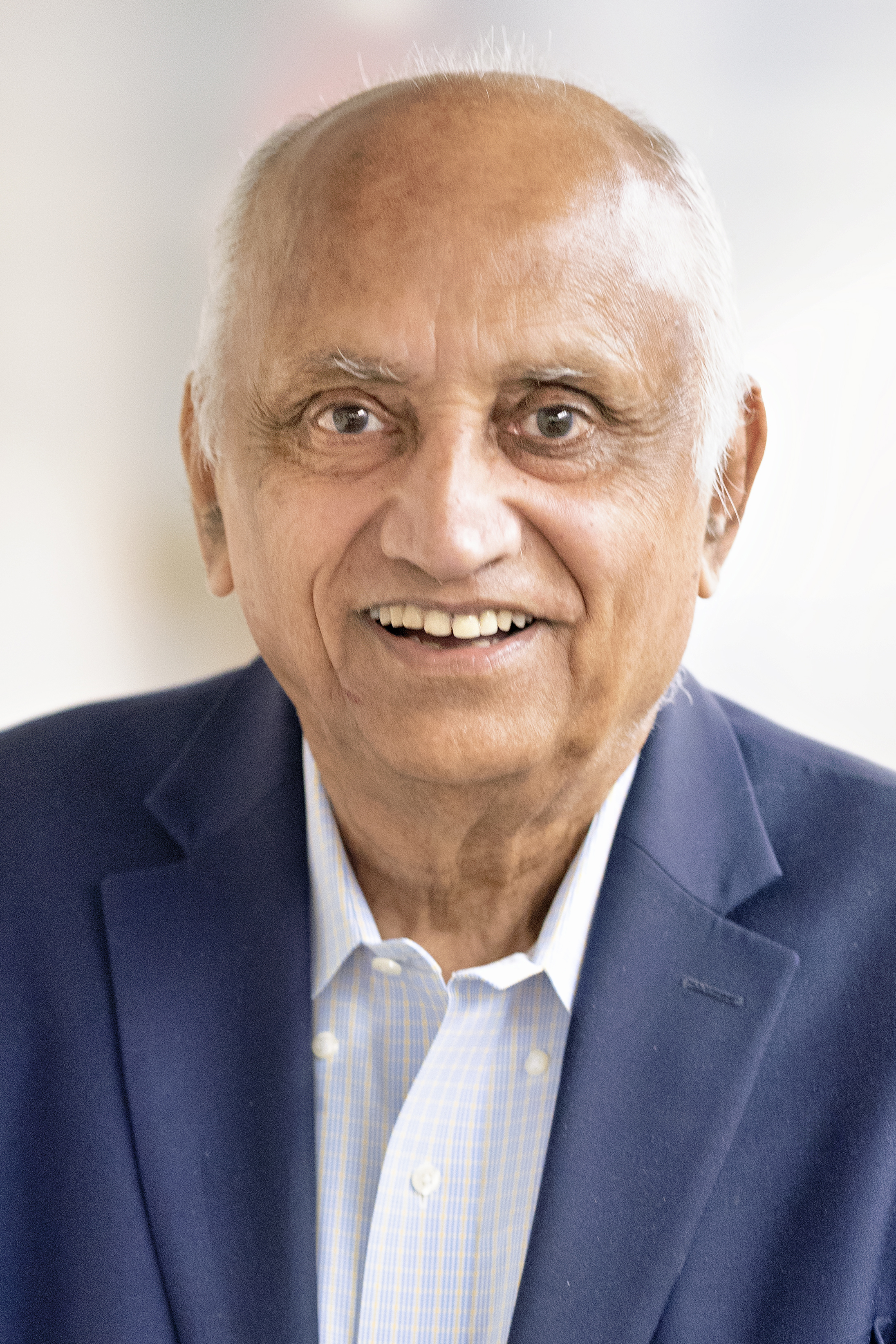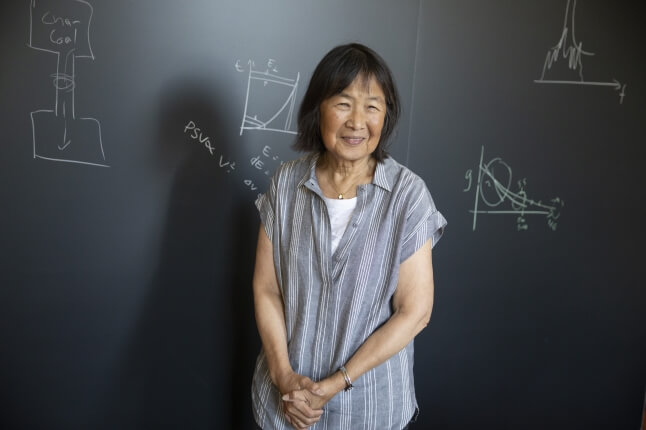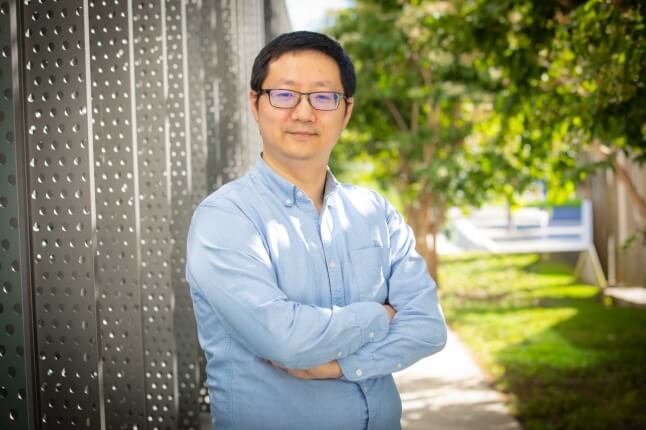News
Venkatesh Narayanamurti, Benjamin Peirce Research Professor of Technology and Public Policy. (Image courtesy of Eliza Grinnell/Harvard SEAS)
Venkatesh “Venky” Narayanamurti, the Benjamin Peirce Research Professor of Technology and Public Policy at Harvard University and former dean of the Harvard John A. Paulson School of Engineering and Applied Sciences (SEAS), has been awarded the Arthur M. Bueche Award by the National Academy of Engineering (NAE).
The Bueche Award, along with The Simon Ramo Founders Award, which was presented to Thomas Kailath of Stanford University, is one of the highest honors accorded to members of the NAE. Both awards were presented at the annual meeting of the NAE held in Washington D.C on September 30.
The Bueche Award recognizes an engineer who has shown dedication in science and technology as well as active involvement in determining U.S. science and technology policy. Previous winners include William Perry, former Secretary of Defense, John H. Gibbons, Former Advisor to the President for Science and Technology and Charles Elachi, Director of the Jet Propulsion Laboratory.
Narayanamurti was honored for his “for seminal contributions to condensed matter physics and visionary leadership of multidisciplinary research in industry, academia, and national labs that generated research and engineering advances.”
Narayanamurti is credited with developing the field of phonon optics — the manipulation of monoenergetic acoustic beams at terahertz frequencies — and is active in the field of semiconductor nanostructures.
“I am honored by this peer recognition and humbled when I look at the list of past award winners who embodied Arthur Bueche’s many-faceted contributions to science and technology policy and in fostering deeper engagement between universities, industr, and government,” Narayanamurti told the crowd of about 850 people at the awards ceremony.
In his acceptance speech, Narayanamurti spoke about his experiences at Bell Labs, where he worked for many years before taking leadership positions at Sandia National Laboratory, UCSB and, eventually, Harvard.
Narayanamurti reflected on the lessons learned from contemporary social science and policy research and his own lifetime of practice in science and technology. Among those lessons is that “basic” research and “applied” research “are mutually reinforcing and are in harmony and not in opposition to each other” and how research is “critically dependent on its people.”
"The nurturing of people is fundamental for research success," Narayanamurti said. "An intellectually challenging environment with a high tolerance for failure and long-term, stable funding is required for research to flourish. Recruitment, mentoring, coaching, and the fostering of an egalitarian, meritocratic, open-door culture are essential elements for our future success."
As dean of Harvard’s SEAS for 10 years, he directed the renewal and expansion of the former division, its transition to a school, the recruitment of junior and senior faculty, and a 60 percent growth in sponsored research. He was an early champion of interdisciplinary initiatives and collaboration, reaching out to colleagues in the Faculty of Arts and Sciences as well as Harvard’s Medical School, Business School, and School of Public Health to establish new partnerships. Under his leadership, SEAS faculty developed creative and innovative programs to attract students, including new courses of study in computer science, electrical engineering, and bioengineering at the graduate and undergraduate levels.
Narayanamurti is an elected member of the National Academy of Engineering and Royal Swedish Academy of Engineering Sciences, and a fellow of the American Academy of Arts and Sciences, American Physical Society, American Association for Advancement of Science, Institute of Electrical and Electronics Engineers, Indian Academy of Sciences, and Indian National Academy of Engineering.
Full Acceptance Remarks
Thank you to the Awards Committee, its chair Ray Baughman, NAE chair Gordon England, and President Dan Mote. I learned that I had received the 2018 Bueche Award in early June. I was at the airport in Hong Kong waiting for a flight to Shanghai when President Mote left me a voicemail message that he wanted to talk. He said it would be “brief and not too painful.” I was pleasantly surprised when he told me about the purpose of his call. Thank you, Dan, for this “not too painful” news! I also want to use this occasion to thank you for your considerable past support during my term as foreign secretary. Your championing of NAE‘s global role, with sister academies, and the Global Grand Challenges facing society has been, from my perspective, a highlight of your presidency.
It is with deep gratitude that I accept the 2018 Arthur M. Bueche Award. At the time of his passing in 1982, Arthur Bueche was senior corporate vice president of the General Electric Company and a member of the NAE Council. I am honored by this peer recognition and humbled when I look at the list of past award winners who embodied Bueche’s many-faceted contributions to science and technology policy and to fostering deeper engagement between universities, industry, and government.
After my graduation from Cornell I applied to two industrial labs: Bell Labs, whose origins could be traced to the great inventor Alexander Graham Bell; and GE Labs, whose roots go back to the great inventor Thomas Edison and Edison Electric Co. I did not get an offer from GE, but I did get an offer from Bell Labs—an institution where I spent much of my formative scientific research career, which subsequently led to leadership positions at Sandia National Laboratory, UC Santa Barbara, and Harvard.
Each position has broadened my horizons: on the role of national laboratories and research universities in the science and technology ecosystem and on the relationship between technology and society. At the launch of the engineering school at Harvard in 2007, Chuck Vest pointed out in his keynote address that it represented Harvard’s recognition that “technology is an integral part of liberal education.” Paraphrasing Winston Churchill in a different context, Vest said: “Harvard takes a long time to do things, but eventually does the right thing!” Undergraduate enrollment in computer science and engineering disciplines has increased from 7 percent of Harvard College in 2007 to 20 percent today. Harvard engineers understand not only how things work, but also how the world works. As former President Summers often said, Harvard celebrates both Einstein and Edison.
I stepped down from my deanship of the Harvard Paulson School of Engineering and Applied Sciences in the fall of 2008 and have since held a joint professorship in technology and public policy with the Paulson School and the Kennedy School of Government. This has allowed me to reflect on lessons learned from contemporary social science and policy research and my own lifetime of practice in science and technology. There are four lessons I would like to briefly share with you.
First, scholars and practitioners of science and technology have largely moved past the once dominant linear model of innovation in which “basic” research is thought to precede “applied” research. Optimizing R&D funding requires connecting scientific inquiry and engineering invention with their applications. These activities are mutually reinforcing and are in harmony, not in opposition to each other. As a historical aside, Vannevar Bush, the legendary science advisor during World War II, popularized the term “basic research.” Frank B. Jewett, past president of Bell Labs, was one of his key advisors. Apparently, Jewett was offended by the term “pure” research: Did Bush mean to imply, he wondered, that the research Bell Labs did was “impure”?
Second, history is replete with examples of great engineering inventions—such as the transistor, the laser, MRI, and the solar cell—that led to scientific discoveries. Engineering inventions and scientific discoveries are both part of a virtuous cycle that propels broader innovation.
My third observation is that the unity of “basic” and “applied” research activities was a major factor in highly productive corporate R&D activities in the 20th century. Examples abound from AT&T Bell Labs, Xerox, IBM, General Electric, DuPont, and others. For example, when I was at Bell Labs in the 1970s and 1980s, researchers made enormous strides in artificially tailored thin-film materials, which led to scientific discoveries in semiconductor quantum physics. These advances led simultaneously to the creation of the high electron mobility transistors that are in every cell phone, and tiny communication lasers that make possible high-speed fiber-optic communication across the globe.
My experience at Bell Labs taught me the importance of materials research as a linking discipline, and that one form of research cannot be separated from another. It also taught me that you learn by doing and there is great joy not only in discovery but also when you are able to do what you could not previously do!
Here is the fourth and final lesson I will share. Since my time at Bell Labs, corporate R&D has shifted dramatically toward only those R&D activities that can produce immediate returns. This leaves the public sector with the responsibility to support long-term, mission-focused R&D. It also means that universities and national laboratories must play an even larger role in breaking down the barriers between disciplines and in working on the most pressing grand challenges facing society. In the public sector, this was partially recognized in the 1960s by the Department of Defense research agencies when they created Materials Research Laboratories (MRLs), which were subsequently transitioned to the National Science Foundation (NSF). Under the directorship of Eric Bloch, former IBM vice president and the first winner of the Bueche Award, the NSF created Engineering Research Centers (ERCs) and Science and Technology Centers (STCs) in the 1980s. This culture has only recently penetrated the Department of Energy (DOE). In 2009, under the leadership of another Bell Labs alumnus, Secretary Steven Chu, DOE created Energy Innovation Hubs, Energy Frontier Research Centers, and ARPA-E to bridge the divide between basic and applied research. The other federal mission-oriented research agency, the National Institutes of Health (NIH), has also recognized the need for reform. A recent American Academy of Arts and Sciences study, which I co-chaired with Keith Yamamoto, strongly advocates for a deeper union between physical sciences, engineering, and the life sciences and medicine via transdisciplinary research.
I want to end my talk with the reminder that progress in any area is critically dependent on people. The nurturing of people is fundamental for research success. An intellectually challenging environment with a high tolerance for failure and long-term, stable funding is required for research to flourish. Recruitment, mentoring, coaching, and the fostering of an egalitarian, meritocratic, open-door culture are essential elements for our future success.
I personally have benefited greatly from the mentoring and support I have received over the years from my teachers, students, and postdoctoral colleagues and staff members in the many institutions I have been associated with. They are so many that I regret that I must acknowledge them collectively. I was blessed with my parents as role models—my father got me interested in science and laboratory research, and my mother was a very people-oriented person who always showed concern for others. I have had an incredibly supportive spouse for 57 years who has been a guiding force in my peripatetic career. We are blessed with three children and seven grandchildren who are our pride and joy.
Many thanks again to the Academy for this honor!
Venkatesh Narayanamurti
Topics: Awards
Cutting-edge science delivered direct to your inbox.
Join the Harvard SEAS mailing list.
Scientist Profiles
Venkatesh Narayanamurti
Benjamin Peirce Professor of Technology and Public Policy, Engineering and Applied Sciences, and Physics, Emeritus
Press Contact
Leah Burrows | 617-496-1351 | lburrows@seas.harvard.edu




